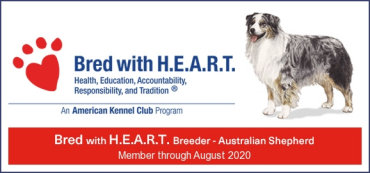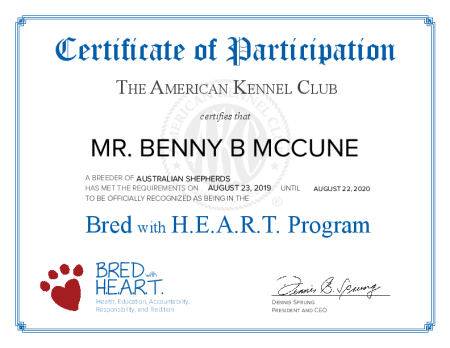

HONEYCREEKAUSSIES.COM
Australian Shepherds - The Breed that Works.
Honeycreek Australian Shepherds
We Love Our Friends
Aussie's - Loyal, Playful, Loving
The Family Welcomes You To Our World

Grain Free Food and More.
Grain Free diet or not plus the Ingredients of Pet Food?
There has been a lot of talk about the Grain Free Foods and the diet process for dogs or cats or for that matter any animal lately but you must read the wording correctly. They are talking about foods you feed your pet, lets talk about dogs only for now as that is what we have and their complete 100% diet. Did you read that? Let me say it again, Complete 100% diet those key words are important as most are not reading the wording as posted by the FDA ( full story can be found here, https://www.fda.gov/animal-veterinary/news-events/fda-investigation-potential-link-between-certain-diets-and-canine-dilated-cardiomyopathy ) they are talking about using a 100% Grain Free Food Diet.
That in user-friendly terms you are feeding your dog 100% Grain Free foods. This is where in my opinion people are taking it to the extreme. So you feed one of the Grain Free foods on the market and you see this article about how it may be causing heart condition concerns. You get all excited and start blaming the food manufacture for making a food of poor quality and disguising it is good for your dog. Now who really is at fault here you or the manufacture of the food you have been using for years? My personal thought is YOU the buyer. Why, read further to find out.
A Grain Free Diet is like like giving your pet a High Protein only diet or better yet just like a human on the Atkins diet plan. Now that can be good for a while but has been proven not to be sustainable without having other items to make up for the loss your body take when on a high protein diet only. So if it is not good for us why would we think it is good for our pets? But in this case we blame the pet food manufacturer for making such a food. Are you starting to understand yet why I blame us more so than the manufacturer?
We know better but we forget all and leave it up to someone else to tell us on our pets then blame and flame them if something goes wrong or something is not right. Again I ask who really is at fault???
So all that being said if you now are starting to have that little light bulb come on in your head let us go further into the question of is Grain Free food good or bad and let me first before proceeding say I am NOT a scientist, chemical engineer, Veterinarian or anything the likes. I am only a Dog Person who loves my pets, who considers them part of my family and who desires the best I can do for their well being.
Our Advice and what we do for our Aussie family members.
So 100% Grain Free Diet proven not to be the right way to go so now what? Simple, mix your food. What did I say? Mix your food. Now how simple is that. But why pay for that expensive food and then mix it because it lacks or overpowers in some areas, what is the purpose of what I am saying! Think about it a minute, turn it to yourself everything can be figured out if you turn it to you and think on it. You cannot eat Beef steaks everyday and nothing else, NOTHING ELSE. Though you may like it your body will begin to fail, but your eating quality T-Bone Steaks. It is not enough for you to maintain a good healthy body. So would you sue, complain, rant and rave at your local farmer for having poor quality steaks since your eating and paying for them? I would think not as YOU knew or should have known the downside of doing so. So then what make you think a pet food is any different, light come one yet?
How would you fix your diet of Steaks only? I would think you would add or lets say mix something into your diet to make up for the loss. DING? Light should now be on. That good high quality grain free food you have been using is still very good for your pet but it needs an additive to be even better or at the very least it needs you to step back and think about what you are doing, about what you are feeding and about what your pet needs are.
We raise Australian Shepherds, Standard size. These are highly active dogs meaning they hardly ever walk anywhere but usually run or are at a accelerated pace at all times, working, playing or whatever they do it with intent. So these are in need of a good high protein food to balance their activity level but also need fat, grains in moderation, vitamins and more. Now I am not an expert on all breeds but for sack of argument would you say that the needs of a Bulldog are the same energy needs of a Australian Shepherd, NO. So why would you even thing of feeding a high energy rated food to a Bulldog? Again I ask if you are is it the Manufacturers fault or your lack of or or laziness in doing a little research into the needs of your family member?
Continue feeding that grain free food but find another food with a good fat level, grains, vitamins as the needs of your pet require this way in my personal opinion my family member gets it all in short they get their steak and veggies to just like you.... Simple Fix...
A little about Ingredients in Dog Food.
All the up roar about ingredients in our pet foods, how many read the words and go full cocked at what they reading without doing so much as looking for the what and whys. So easy to push the blame form your self to others because you either do not want to do a little research, to lazy to do so or are just so confident in what others say you let it slip by you without a thought further into the matter. So let us look a bit, granted this will not be in depth just a glance at what is in your pet food and what it really is.
Reading the ingredient list on your pet food label should be what you do at all times as well as looking at the expiration date listed, yes animal foods have a expiration date listed. But understanding it can be overwhelming. So key things to remember when doing research on the label of your choice of food is an ingredient list is required to display all ingredients in decreasing amounts (by weight) used in the product, so the biggest contributors are first and the smallest are last.
Envision the list of ingredients as major and minor ingredients. The major ingredients will be the first few listed at the beginning of the ingredient list, most of them will bear names like animal or plant products. The minor ingredients are mostly ingredients supplying minerals, vitamins, and other nutrients as well as a lot of chemical sounding names. Other minor ingredients include preservatives, conditioning agents, emulsifiers, stabilizers, and colors or flavoring agents.
Below as explained by the AAFCO (Association of American Feed Control Officials). The entire page can be found here, https://www.aafco.org/Consumers/What-is-in-Pet-Food credit hereby given.
Meat.
Meat is the clean flesh derived from slaughtered mammals and is limited to that part of the striate muscle which is skeletal or that part which is found in the tongue, in the diaphragm, in the heart or in the esophagus; with or without the accompanying and overlying fat and portions of the skin, sinew, nerve, and blood vessels which normally accompany the flesh. It shall be suitable for animal food.
Poultry is the clean combination of flesh and skin with or without accompanying bone, derived from the parts or whole carcasses of poultry or a combination thereof, exclusive of feathers, heads, feet and entrails. It shall be suitable for use in animal food.
Meat By-Products.
Meat by-products is the non-rendered, clean parts, other than meat, derived from slaughtered mammals. It includes, but is not limited to, lungs, spleen, kidneys, brain, livers, blood, bone, partially de-fatted low temperature fatty tissue, and stomachs and intestines freed of their contents. It does not include hair, horns, teeth and hoofs. It shall be suitable for use in animal feed.
Poultry By-Products.
Consist of non-rendered clean parts of carcasses of slaughtered poultry such as heads, feet, viscera, free from fecal content and foreign matter except in such trace amounts as might occur unavoidably in good factory practice.
Rendered Products.
The following materials are all rendered products that have been subject to cooking to destroy any harmful bacteria before they are shipped to a pet food manufacturing plant. Rendering is a process where the materials are subject to heat and pressure, removing most of the water and fat and leaving primarily protein and minerals. You will notice that the term meal is used in all cases; because, in addition to cooking, the products are ground to form uniform sized particles.
The rendering process is designed to destroy disease-causing bacteria, leaving an ingredient high in protein that while unappetizing to people appeals to the carnivore's palate. Unlike meat and meat by-products, this ingredient may be from mammals other than cattle, pigs, sheep or goats without further description. However, a manufacturer may designate a species if appropriate (such as beef meal if only from cattle).
Meat Meal.
The rendered product from mammal tissues, exclusive of any added blood, hair, hoof, horn, hide trimmings, manure, stomach and rumen contents except in such amounts as may occur unavoidably in good processing practices. It shall not contain extraneous materials not provided for by this definition.
Meat and Bone Meal.
The rendered product from mammal tissues, including bone, exclusive of any added blood, hair, hoof, horn, hide trimmings, manure, stomach and rumen contents except in such amounts as may occur unavoidably in good processing practices. It shall not contain extraneous materials not provided for by this definition.
Animal By-Product Meal.
The rendered product from mammal tissues, exclusive of any added hair, hoof, horn, hide trimmings, manure, stomach and rumen contents except in such amounts as may occur unavoidably in good processing practices. It shall not contain extraneous materials not provided for by this definition. This ingredient definition is intended to cover those individual rendered animal tissues that cannot meet the criteria as set forth elsewhere. May consist of whole carcasses, but often includes by-products in excess of what would normally be found in meat meal and meat and bone meal.
Poultry By-Product Meal.
Consists of the ground, rendered clean parts of the carcasses of slaughtered poultry such as necks, feet, undeveloped eggs and intestines, exclusive of feathers except in such amounts as might occur unavoidably in good processing practices.{the definition goes on to include the required mineral specifications and required nutrient guarantees}. If the product bears a name descriptive of its kind, it must correspond thereto.
Poultry Meal.
The dry rendered product from a combination of clean flesh and skin with or without accompanying bone, derived from the parts or whole carcasses of poultry or a combination thereof, exclusive of feathers, heads, feet and entrails. It shall be suitable for use in animal food. If it bears a name descriptive of its kind, it must correspond thereto.
Some other ingredients.
Animal and vegetable fats or oils are commonly used to supply additional energy and flavor to a pet food.
Plant ingredients like corn, barley, peas, and potatoes also supply energy and help hold kibbles together.
There are a number of sources of dietary fiber used in pet food, including dried beet pulp, dried chicory root, fructooligosaccharide, powdered cellulose, and inulin.
Ingredients used to supply vitamins and minerals in a pet food.
There are many inorganic compounds used to supply minerals and most of them can be identified by what they supply with names beginning with elements such as calcium, cobalt, copper, ferric or ferrous (meaning Iron), magnesium, manganese, potassium, sodium, or zinc. Others may have the mineral as part of the second half of the name, such as ___iodate (for iodine) or ___selenite (for selenium). Some may include two useful minerals, such as dicalcium phosphate (supplying both calcium and phosphorus).
Synthetic mineral ingredients.
Designated as metal amino acid complexes, metal amino acid chelates and polysaccharide complexes. You may see specific designations, for example, Iron Amino Acid Complex, Magnesium amino acid chelate or Zinc polysaccharide complex. The theory behind these synthesized ingredients is improved bioavailability compared to strictly inorganic mineral compounds.
Examples of ingredients used to provide vitamin activity.
Cholecalciferol (supplies vitamin D from animal sources), Ergocalciferol (supplies vitamin D from plant sources), Vitamin B12 supplement, Riboflavin supplement (a source of vitamin B2), Vitamin A supplement, Vitamin D3 supplement, alpha-Tocopherol acetate (supplies vitamin E), Thiamine mononitrate (source of vitamin B1) and pyridoxine hydrochloride (source of vitamin B6). That is far from all of the ingredients used to supply vitamin activity, but enough to give you an idea.
Other ingredients used in pet foods with chemical sounding names?
Some additives which supply amino acids: DL-Methionine, L-Lysine, L-Threonine, DL-Tryptophan, Taurine (particularly important to cats), DL-Arginine, L-Tyrosine.
Ingredients which function as chemical preservatives.
Ascorbic acid, Benzoic acid, Butylated hydroxyl anisol (BHA), Butylated hydroxyltoluene (BHT), Calcium ascorbate, Citric acid, Ethoxyquin, Potassium sorbate, Sodium bisulfite, Mixed Tocopherols. Some of these preservatives have limits to the amount that can be used or what types of products the preservative can be added to. The fact that a preservative has been added must be shown, such as preserved with BHT or mixed tocopherols (preservative).
Conditioning agents.
Thickeners, emulsifiers, sequestrants, flavors and seasonings might include:
Carrageenan, propylene glycol (in dog food only, propylene glycol is unsafe for cats and is prohibited from use in cat food), sodium hexametaphosphate (dental tartar reduction in dogs and cats), agar-agar, and guar gum.
Spices and extracts that are used for flavorings.
Examples include ginger, chamomile, fennel, rosemary, and a number of extracts of commonly known plants.
Above is of our own formulated opinions for further on that please read the DisClaimer found here HoneyCreek Australian Shepherd Disclaimer for our responsibility.


